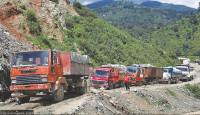Opinion
Green shield
Protecting Nepal’s forests is equally, if not more, in India’s interest too
Navin Singh Khadka
Pavan Sukhdev, an Indian-born economist who was deeply involved in India’s financial market development in the mid-90s, is now a world renowned figure for having led a pioneering study— The Economics of Ecosystems and Biodiversity (TEEB).
“TEEB is focused on making nature’s values visible,” reads the website of the global initiative that conducted the study. “Its principal objective is to mainstream the values of biodiversity and ecosystem services into decision-making at all levels. It aims to achieve this goal by following a structured approach to valuation that helps decision-makers recognise the wide range of benefits provided by ecosystems and biodiversity, demonstrate their values in economic terms and, where appropriate, suggest how to capture those values in decision-making.”
The initiative began after environment ministers from the G8+5 countries proposed an analysis of the global economic benefit and the loss of biological diversity, and the failure to take protective measures against the costs of effective conservation in 2007.
The proposal led to a global study and the result was TEEB, an idea increasingly gaining currency alongside the broadly accepted narrative that a green economy can help combat climate change.
Green wealth
With this global background in mind, now zoom in on Nepal’s lush green forests and try to link them to the fast growing economy of the South Asian region. Nepal’s natural ecosystems and biodiversity indeed provide a cushion for the region’s tens of millions of inhabitants who have to live with the rapid loss of nature caused by intensified infrastructure development.
If, say, the mountains in the Mahabharat range are denuded and the forests in Chure and Bhawar are cleared, the entire Ganges basin will be at direct risk. This means people living in both the Nepali and Indian side of the flatlands and further downstream in Bangladesh will face the ferocity of floods.
Already many in Bihar and Uttar Pradesh accuse Nepal of cutting down trees and adding to their miseries during monsoonal floods every year. And this is when deforestation has not even taken place at alarming levels in the Nepal government-owned jungles and even as most of its community forests have remained intact.
What might they say now when many communities in Nepal, because of the fuel crisis, have actually begun to cut down trees from the same world renowned forests they protected all these years?
Forests under threat
According to Forest Ministry officials, more than 150 bicycles that were brought to illegally transport logs and firewood were seized in a community forest in Rautahat last week.
“We were lucky that the community members caught them and destroyed the bicycles and the forest was saved,” the Forest Department Director General Resham Dangi told me in an interview I did for a BBC report on how the fuel crisis was posing a threat to Nepal’s community forests.
“But if the fuel crisis persists, we may not see such resistance from the communities as they themselves will need fuel for their kitchen.”
The need for survival even prompted the Forest Department officials to assess the firewood stock in all of their district offices. And they found that there were 3.4 million kgs of firewood which could last for six weeks of supply to Kathmandu. The government agencies appeared even prepared to cut down trees if the situation persisted.
These are very disturbing signs. But to say so is in neither intended to discredit the Madhes Movement nor to provide any leverage to Kathmandu to ignore the genuine demands of the Madhesis.
There have been repeated warnings that if the natural ecosystem in Chure collapses, it will be the worst nightmare for Bihar and Uttar Pradesh in India.
The alarms have been sounded following the increase in illegal plundering of the natural resources also driven by the demand from the two bordering Indian states for their rapid infrastructure development.
If this is how things are now, imagine what might happen if the government and communities both find it legitimate to cut down trees for fuel?
In India’s interest
This is why India should worry. It has recognised the value of the Himalayan ecosystem in its national action plan on climate change. Of the eight national missions identified by the document, one is for sustaining the Himalayan ecosystem.
“The plan aims to conserve biodiversity, forest cover, and other ecological values in the Himalayan region, where glaciers that are a major source of India’s water supply are projected to recede as a result of global warming.”
This component of the climate change action plan is largely guided by the idea that nature conservation can be an effective weapon to combat climatic changes. A section of the global scientific community believes that if we have well conserved natural resources, they will help us minimise unavoidable impacts of climate change.
This is where the TEEB analysis also comes into play—the protection of ecosystem and biodiversity result into economic values as communities are to a large extent shielded against climate-induced losses.
With its double-digit growth goal, New Delhi’s economic activities will surely increase in the days to come. But it will need protected natural resources to act as sponge that will absorb the ecological impacts of development and manufacturing works and at the same time, enable communities to face the inevitable climatic changes.
Nepal’s forests mainly give northern India that ecological safeguard, particularly because they also regulate the thousands of rivers and rivulets flowing down from Nepali mountains into Indian territories.
New Delhi should register this in its list of national interests.
Khadka is BBC journalist based in London




 24.12°C Kathmandu
24.12°C Kathmandu










